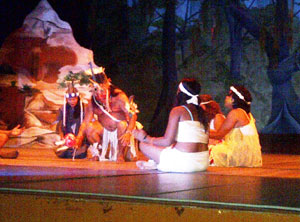RED-faced devils, strange masked women, supple dancers and splendidly attired Amerindians all took to the National Cultural Centre stage last Saturday, as contingents from French Guiana and Suriname showed off their respective cultures as part of the recently held Inter-Guiana Cultural Festival.  The French Guiana contingent went first, members highlighting their country’s carnival celebration, which is a major aspect of their culture.
The French Guiana contingent went first, members highlighting their country’s carnival celebration, which is a major aspect of their culture.
Though rooted in the Creole culture, it is an event in which everyone participates.
Opening the spectacular evening was the Touloulous, the most famous element of the French Guiana Carnival. The Touloulous played out the story, and danced with other characters as a narrator told the tale.
 Touloulous are women who, during the nights of carnival, dress in elaborate costumes and masks to become unrecognizable. Each costume is designed to mask the wearer’s identity; skin colour; and beauty, or lack thereof.
Touloulous are women who, during the nights of carnival, dress in elaborate costumes and masks to become unrecognizable. Each costume is designed to mask the wearer’s identity; skin colour; and beauty, or lack thereof.
During carnival season in French Guiana, Touloulous enter the dance hall for free, and are given condoms to help prevent social diseases from spreading in the towns. Men have to pay admittance, are not in disguise, and can’t refuse a Touloulou’s request for a dance.
Carnival in French Guiana is a time for a woman of any status and beauty to have power. If an undisguised woman gets up to dance, the orchestra stops playing. Alcohol is served, and Touloulous pick up men, whispering, “Touloulou thirsty.” She drinks through a straw, so her identity is not compromised.
 In recent carnivals, men have tried to regain the upper hand by organizing soiree touloulo in which the men wear disguises and try to woo out-of-costume women. The effect just isn’t the same, and carnival remains the Touloulous’ chance to be on top.
In recent carnivals, men have tried to regain the upper hand by organizing soiree touloulo in which the men wear disguises and try to woo out-of-costume women. The effect just isn’t the same, and carnival remains the Touloulous’ chance to be on top.
In French Guiana, other mythical characters appear regularly in the parades, including Karolin, a small person dressed in a magpie tail and top hat; the Les Nèg’marrons, who are groups of men dressed in red loincloths, bearing ripe tomatoes in their mouths and having their bodies smeared with grease or molasses. These men deliberately try to come in contact with spectators so they can soil those spectators’ clothes. Then there are Les makoumés — men in drag (out of the carnival context, makoumé is a pejorative term for a homosexual); and the Soussouris (the bat), a character dressed from head to foot in a winged leotard, usually black in colour. Traditionally malevolent, this character is liable to chase spectators and “sting” them.
These men deliberately try to come in contact with spectators so they can soil those spectators’ clothes. Then there are Les makoumés — men in drag (out of the carnival context, makoumé is a pejorative term for a homosexual); and the Soussouris (the bat), a character dressed from head to foot in a winged leotard, usually black in colour. Traditionally malevolent, this character is liable to chase spectators and “sting” them.
Other elements of French Guianese culture showcased that evening included the retelling of folk tales with the aid of a boot; and marionettes, young artists showing off their painting skills against tantric images on a projected backdrop, dancing and pulsating African beats done by live performers.
After a brief intermission, the Suriname took charge of the second half of the evening. Their presentation was based on a Surinamese play, “The Confrontation”, which featured the indigenous people of Suriname living in a natural rainforest environment.
The Surinamese had been wowing visitors even before the start of the evening, welcoming visitors to the NCC with an energetic display of dancing and drumming, pausing only to take photos with admirers.
They continued the show during intermission as well. One musician showed his skill playing along, outside in the foyer, to the strains of a popular pop song, alternating between the pan pipe and the flute.
 On the stage, the Surinamese charmed their audience with beautiful costumes, dances and drumming.
On the stage, the Surinamese charmed their audience with beautiful costumes, dances and drumming.
This time last week, the second ever Inter-Guiana Cultural Festival (IGCF), hosted by Guyana, was in its final day.
The objectives of the festival were to explore and identify common historical and other ties between the Guianas, regardless of political borders; to conduct interactive workshop sessions between the artistes, artisans of the Guianas; and finally, to showcase aspects of the culture in six stipulated disciplines, thereby fostering unity and understanding among the peoples of the Guianas.
The disciplines explored were: Performing Arts, Literature, Culinary Arts, Fashion, Film, and Visual Arts.
The festival lasted between August 23 and August 27, 2012, in Georgetown, Guyana. The inaugural festival was held in Paramaribo, Suriname, from August 26-28, 2011.




.jpg)








